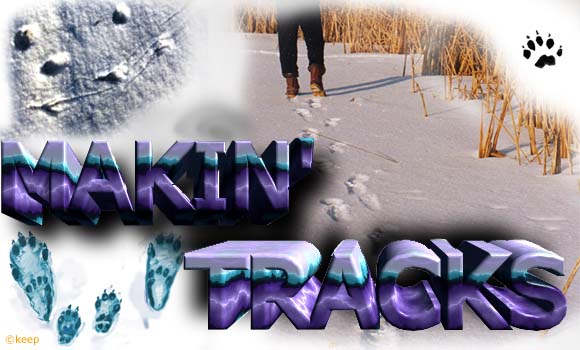
By Doug Collicutt
[Click here for a newer version of this article!]
Every morning, the same routine. Pour a coffee, open the blinds, survey the neighbourhood. Another gloomy winter's day. "Hmmm, mail man's been already, that's early. Wonder what came today, probably bills. Boy, Rita's been out somewhere already and back again. Paper hasn't been delivered yet, Joan will be ticked. And that darn cat's been on top of our car again."
By now you've surmised that I'm a nosy neighbour, but how, you might ask, did I know all that from just glancing out my window. Elementary, my dear reader. I neglected to mention the first observation I made from my living room window. It had snowed overnight. The rest was simple deduction based on my prior knowledge.
A fresh dusting of snow is like putting out a slow acting photographic film. It keeps a record of everything that's happened, or that hasn't happened. Follow my deductions:
- I could see that the mail man, and
yes our mail carrier is currently a man, had been because I recognized
his foot prints on my walkway. He has large boots with a distinctive
tread, and takes long strides. His female counterpart on this route
tends to wear shoes, even in winter, and leaves a smaller print with
a shorter stride.
- Rita's been out and back again? There's
no snow on her van anymore and tire tracks lead away from and then
back into the spot where she parks on the street. I know it was her
driving, because her husband leaves early for work. Hmmm, maybe she
drove him to work today?
- There are no tracks up the walk to
Joan's house so there was no mail for her today and the paper carrier
hasn't been either. Joan's quick to phone if the paper isn't there
on time.
- And there's a distinctive line of small paw prints running from a large smudged area on one side of our car's hood to the other side. I think that cat uses our car as a vantage point to survey the neighbourhood. He always chooses our car, probably because he knows it bugs me.
 I like knowing what's going
on in my neighbourhood and a fresh winter snow helps me keep
tabs on things. Snow and the tracks left in it are great for
keeping tabs on all sorts of things. When you combine an
ability to recognize the shape and arrangement of tracks
with some foreknowledge of the inhabitants of an area and
the of recent weather, you can gain a lot of insight. This
goes for human neighbourhoods and for critters in the wild,
too.
I like knowing what's going
on in my neighbourhood and a fresh winter snow helps me keep
tabs on things. Snow and the tracks left in it are great for
keeping tabs on all sorts of things. When you combine an
ability to recognize the shape and arrangement of tracks
with some foreknowledge of the inhabitants of an area and
the of recent weather, you can gain a lot of insight. This
goes for human neighbourhoods and for critters in the wild,
too.
Winter is a great time to observe and appreciate the activities of critters, even when you don't actually see them! I like to think of every set of tracks as a mystery. What critter made the tracks? Where did it come from? Where was it going and what was it doing? Following and interpreting tracks in the snow is fun and can earn you new insights into the lives of Manitoba's wildlife. We've prepared a little guide to help you identify the tracks of some of our critters, together with some tips on how to interpret what you see. So, next time you're out for a walk in the park or a cross country ski, you'll be prepared to do a little wildlife "sleuthing".
|
Sorry, but you won't see any pictures of the animals that make tracks in this article. And that's on purpose! The point of looking for and interpreting tracks is not to locate and see the animals that made the tracks -although that does happen some times. We want you to think of tracks as interesting in themselves, for what they can teach you about animals. They are usually more revealing than an actual sighting of an animal, because they are signs of what it was doing when it was undisturbed by human presence. |
Carry on, for more on Winter Tracks (Click the right arrow below).
Or jump right to our guide to Manitoba critter tracks:
NNZ Tracking Guide
